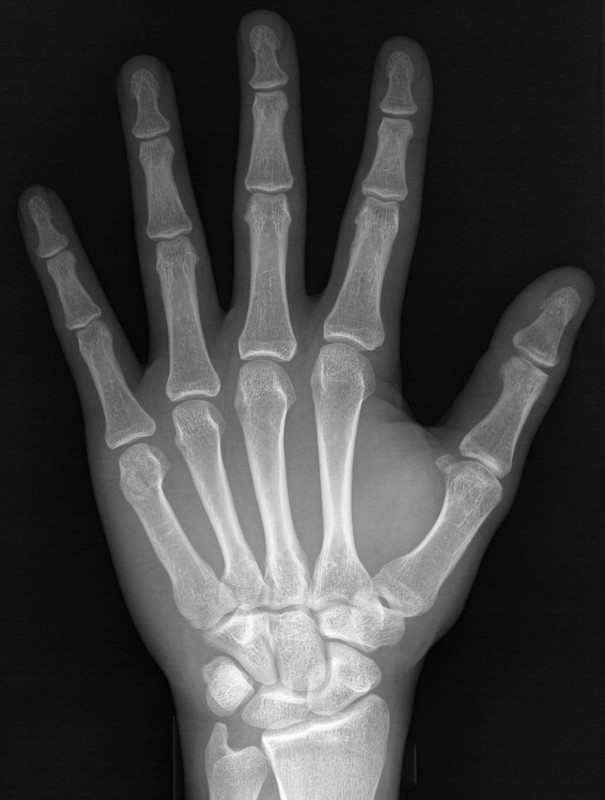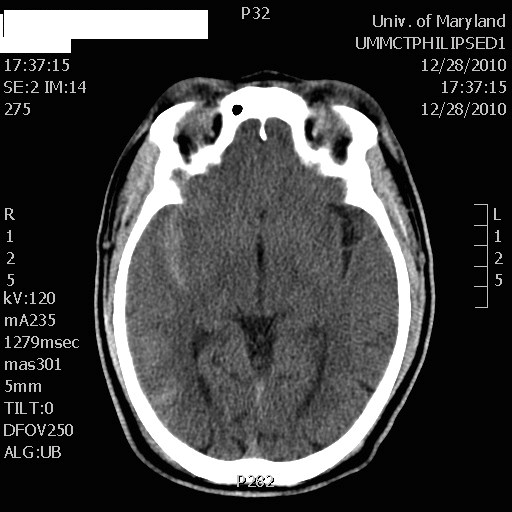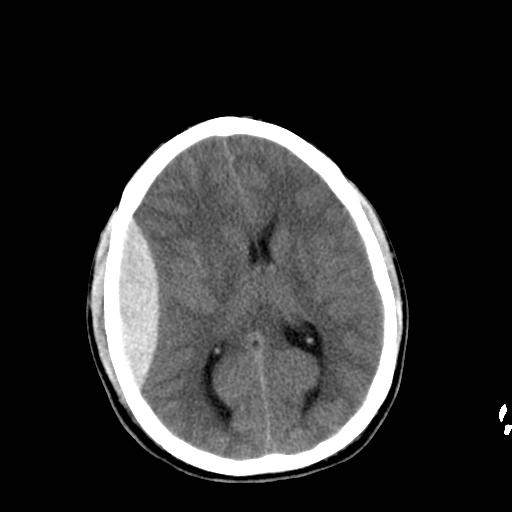Category: Neurology
Keywords: parkinson's disease, movemnt disorder, levodopa (PubMed Search)
Posted: 1/20/2011 by Aisha Liferidge, MD
Click here to contact Aisha Liferidge, MD
Category: Critical Care
Keywords: Apnea test, brain death, brain stem death, coma, death, cardiopulmonary death (PubMed Search)
Posted: 1/17/2011 by Haney Mallemat, MD
Click here to contact Haney Mallemat, MD
Brain death is the permanent absence of cerebral and brainstem functions (coma, absent pupillary reflexes, no spontaneous respiration, etc.). Legally, brain death is equivalent to cardiopulmonary death.
If brain death is suspected, confirmation is necessary. The apnea test is most commonly used, evaluating for spontaneous breaths when disconnected from the ventilator. If apnea testing is not possible (e.g., ambiguous clinical exam or cardiopulmonary instability) ancillary testing is needed:
Wijdicks EF, The diagnosis of brain death. N Engl J Med. 2001 Apr 19;344(16):1215-21.
Category: Visual Diagnosis
Keywords: boxer's, fracture, orthopedics, hand, brawler's, radiology, xray (PubMed Search)
Posted: 1/17/2011 by Haney Mallemat, MD
Click here to contact Haney Mallemat, MD

Boxer's (or Brawler's) Fracture
Many thanks to Dr. George Kochman for submitting this case!
Category: Cardiology
Keywords: infective endocardtiis, neurological, deficits (PubMed Search)
Posted: 1/16/2011 by Amal Mattu, MD
Click here to contact Amal Mattu, MD
Up to 30-40% of patients with infective endocarditis have neurological symptoms as a result of embolization. This is a good reminder of the frequency of embolization, and also that infective endocarditis should always be part of the differential when you are evaluating a patient with fever + neurological abnormalities.
Limkakeng AT Jr., Stahmer SA. Cardiovascular II. In Harrigan RA, Ufberg JW, Tripp ML (eds). Emergency Medicine Review: Preparing for the Boards. Elsevier, St. Louis 2010.
Category: Orthopedics
Keywords: Shoulder, Dislocation, FARES (PubMed Search)
Posted: 1/15/2011 by Michael Bond, MD
Click here to contact Michael Bond, MD
FARES Method for Reduction of Anterior Shoulder Dislocations.
This method that was recently highlighted in a publication had a ~78% success rate with the authors able to reduce the shoulder in an average of 2.36 ±1.24 minutes without having to give the patients any analgesics or sedatives. The technique is done by:
Consider trying this with your next shoulder dislocation. No single method of reduciton is 100% successful, but methods like this that only require a single provider and do not require analgesics are extremely helpful in improving patient flow as they do not utilize a lot of ED resources..
Category: Toxicology
Keywords: acetaminophen, rumack-matthew nomogram (PubMed Search)
Posted: 1/13/2011 by Bryan Hayes, PharmD
Click here to contact Bryan Hayes, PharmD
The Rumack-Matthew nomogram is a well studied and validated tool to help assess the potential for liver toxicity following acute acetaminophen poisoning. Here is a brief review of when it is best utilized.
Outside-the-box situations:
Category: Neurology
Keywords: dysmetria, ataxia, cerebellum (PubMed Search)
Posted: 1/12/2011 by Aisha Liferidge, MD
Click here to contact Aisha Liferidge, MD
Category: Critical Care
Posted: 1/11/2011 by Mike Winters, MBA, MD
(Updated: 12/13/2025)
Click here to contact Mike Winters, MBA, MD
Dexmedetomidine for Sedation in Acute Neurologic Disease
Mirski MA, Lewin JL. Sedation and analgesia in acute neurologic disease. Curr Opin Crit Care 2010; 16:81-91
Category: Neurology
Keywords: Image, CT scan, head trauma (PubMed Search)
Posted: 1/10/2011 by Rob Rogers, MD
Click here to contact Rob Rogers, MD
FILE RESEND. This was tested via email and will hopefully work. I apologize for errors - Dlemkin (webmaster)

What is the diagnosis? (DON'T LOOK DOWN AT THE ANSWER)
50 year-old male prisoner s/p assault, + LOC
CT shows right-sided traumatic subarachnoid hemorrhage
Category: Cardiology
Keywords: therapeutic hypothermia, hypothermia, saline, cardiac arrest (PubMed Search)
Posted: 1/9/2011 by Amal Mattu, MD
Click here to contact Amal Mattu, MD
Therapeutic hypothermia is generally accepted as a useful intervention that should be employed in patients that are resuscitated after cardiac arrest. Many protocols for cooling are relatively complicated, involving endovascular catheters, cooling blankets, cooling helmets, or other devices that are expensive and not widely available. The cooling process can actually be fairly simple, however, with ice and cool IV fluids. The most recent study that demonstrated this used nothing more than application of ice to the groin, neck, and axillae; and administration of 4o C IVF infused at 30cc/kg at 100ml/min via two peripheral catheters. Sedation or paralysis + intubation was used as per the norm.
Patients receiving this simple intervention were able to achieve goal temperature of 32o-34o C within 3-4 hours, and hypothermia was maintained for a full 24 hours before rewarming.
The study shows that expensive equipment and complicated protocols are not necessary for therapeutic hypothermia.
Larsson IM, Wallin E, Rubertsson S. Cold saline infusion and ice packs alone are effective in inducing and maintaining therapeutic hypothermia after cardiac arrest. Resuscitation 2010;81:15-19.
Category: Orthopedics
Posted: 1/8/2011 by Brian Corwell, MD
(Updated: 2/19/2011)
Click here to contact Brian Corwell, MD
Involves an avulsion of the flexor digitorum profundus (FDP) tendon from its insertion on the distal phalanx.
Ring finger is most commonly involved.
Usually occurs from a grabbing attempt (resulting in forced DIP extension during maximal FDP contraction) as would occur while attempting to grab someone’s jersey such as in football or rugby.
Clinically, there is normal passive DIP ROM with loss of active flexion. Examine this by asking the patient to flex the fingertip at the DIP while the PIP joint is held in extension.
*Remember that patients with a 90% full-thickness tendon laceration may still have normal (albeit painful) range of motion. The examiner must evaluation the strength of the tendon against resistance. This injury is commonly missed as it is diagnosed as a “jammed” finger.
Plain films may show a bony avulsion, but are often negative.
Treatment is primary repair especially with large bony fragments. Partial ruptures can be treated nonoperatively at the discretion of the hand surgeon.
Category: Pediatrics
Keywords: hypertonic saline, seizures, hyponatremia, hyponatremic, encephalopathy, pediatric, children (PubMed Search)
Posted: 1/6/2011 by Adam Friedlander, MD
(Updated: 1/7/2011)
Click here to contact Adam Friedlander, MD
Hyponatremic seizures are a frightening entity. Anticonvulsants don't work well, and will likely cause apnea well before they halt the seizure. Hypertonic saline carries with it the fear of inducing central pontine myelinolysis (CPM) with overly rapid correction of the hyponatremia.
However:
So, you can safely correct hyponatremia rapidly in the setting of seizures. Do it like this:
Give 2-3 mL/kg of 3% NaCl in rapid sequential boluses, until seizures stop. A theoretical maximum dose is 100mL/kg, but recall that only a relatively small correction is required to stop the seizure.
After you've stopped the seizure, correct the hyponatremia slowly, as you would otherwise.
Category: Toxicology
Keywords: Vitamin K1,anaphylaxis,coumadin,warfarin (PubMed Search)
Posted: 1/6/2011 by Ellen Lemkin, MD, PharmD
(Updated: 12/13/2025)
Click here to contact Ellen Lemkin, MD, PharmD
Smythe MA, Dager WE, Patel NM. Managiing Complications of Anticoagulation Therapy. Journal of Pharmacy Practice 200417(5)327-46.
Dentali F, Crowther MA. Management of Excessive Anticoagulant Effect Due to Vitamin K Antagonists. Hematology 2008;266-9.
DeZee K et all. Treatment of Excessive ANticoagulation with Phytodione. Arch Intern Med Feb 27, 2006;166:391-7.
Category: Neurology
Keywords: nihss, nih stroke scale, posterior stroke, anterior stroke (PubMed Search)
Posted: 1/5/2011 by Aisha Liferidge, MD
(Updated: 12/13/2025)
Click here to contact Aisha Liferidge, MD
Category: Critical Care
Keywords: PRES, hypertensive crisis, seizures, visual loss, ecclampsia, hypertensive emergency, cyclopsporine, tacrolimus (PubMed Search)
Posted: 1/4/2011 by Haney Mallemat, MD
Click here to contact Haney Mallemat, MD
Posterior reversible encephalopathy syndrome (PRES) is a syndrome of visual loss, headache, altered mental status, and seizures, typically with severe hypertension. PRES usually occurs with hypertensive encephalopathy or ecclampsia, although cyclosporin and tacrolimus use have been implicated.
PRES is due to a combination of endothelial damage, impaired auto-regulation and increased cerebral perfusion pressure. Classic CT and MRI findings are parietal-occipital, cerebellar, or brainstem cortical and subcortical edema.
Early recognition and symptomatic treatment is key; IV anti-hypertensives (hypertensive encephalopathy), anti-epileptics (seizures), IV magnesium and emergent delivery (ecclampsia), and discontinuing offending medications (cyclosporin and tacrolimus).
With treatment, partial to complete recovery is normal, although residual neurological and visual deficits may persist.
Pula, J. Posterior reversible encephalopathy syndrome. Current Opinion in Ophthalmology. 2008 vol. 19 (6) pp. 479-84
Category: Vascular
Posted: 1/3/2011 by Rob Rogers, MD
(Updated: 12/13/2025)
Click here to contact Rob Rogers, MD

60 year-old male s/p assault. + LOC. Awake and normal neuro examination on arrival. Deteriorates in the ED after about an hour....
Diagnosis: Epidural Hematoma
Category: Cardiology
Keywords: therapeutic hypothermia, hypothermia, hypokalemia, cardiac arrest (PubMed Search)
Posted: 1/2/2011 by Amal Mattu, MD
(Updated: 12/13/2025)
Click here to contact Amal Mattu, MD
Induced hypothermia is associated with a decline in serum potassium levels. The cold myocardium is already mildly predisposed to arrhythmias, and the combination of hypokalemia + hypothermia appears to increase the risk of polymorphic ventricular tachycardia. Two simple measures should be taken during post-arrest therapeutic hypothermia:
1. Correct hypokalemia before and during cooling.
2. Monitor the patient's potassium level and QT interval during cooling, and correct as needed.
Mirzoyev SA, McLeod CJ, Bunch TJ, et al. Hypokalemia during the cooling phase of therapeutic hypothermia and its impact on arrhythmogenesis. Resuscitation 2010;81:1632-1636.
Category: Orthopedics
Keywords: peroneal, tendon, subluxation (PubMed Search)
Posted: 1/1/2011 by Michael Bond, MD
Click here to contact Michael Bond, MD
Peroneal Tendon Subluxation: The Other Ankle Sprain
Roth et al. Peroneal tendon subluxation: the other lateral ankle injury. Br J Sports Med (2010) vol. 44 (14) pp. 1047-53
Category: Toxicology
Keywords: naloxone, opioids (PubMed Search)
Posted: 12/30/2010 by Fermin Barrueto
(Updated: 12/13/2025)
Click here to contact Fermin Barrueto
Naloxone is the epitomy of an antidote with complete reversal of opioid toxicity within 60 seconds of administration. Remember your clinical endpoint should be respiratory effort. If you utilize "the vial" of either 0.4mg or 2mg and there is a higher probability of withdrawal and for acute lung injury. Here are some tips for administration:
1) IV Access: Try 0.1 mg or even 0.05 mg - anesthesiology typically doses naloxone in micrograms. Reversal is slower so you have to be patient. It is also not as dramatic so closely monitor respirations to see if you have improvement, that may be all that you get. These are probably patients that you don't want that awake anyways.
2) No IV Access: advantage of naloxone is it is bioavailable IV, intranasal and even by nebulizer. Here you want the dose to be 0.4mg to start for intranasal. Nebulizer is difficult to measure and probably safe to start with 2mg in the nebulizer container.
There is a difference when you know it is an opioid overdose and are reversing apnea versus a diagnostic administration to determine if it is opioid toxicity. In the latter instance you can rationalize the large dose - just be ready and be sure you are not in line of the possible projectile vomiting.
Category: Neurology
Keywords: seizure, seizure disorder, felbamate, antiepileptics (PubMed Search)
Posted: 12/29/2010 by Aisha Liferidge, MD
(Updated: 12/13/2025)
Click here to contact Aisha Liferidge, MD
